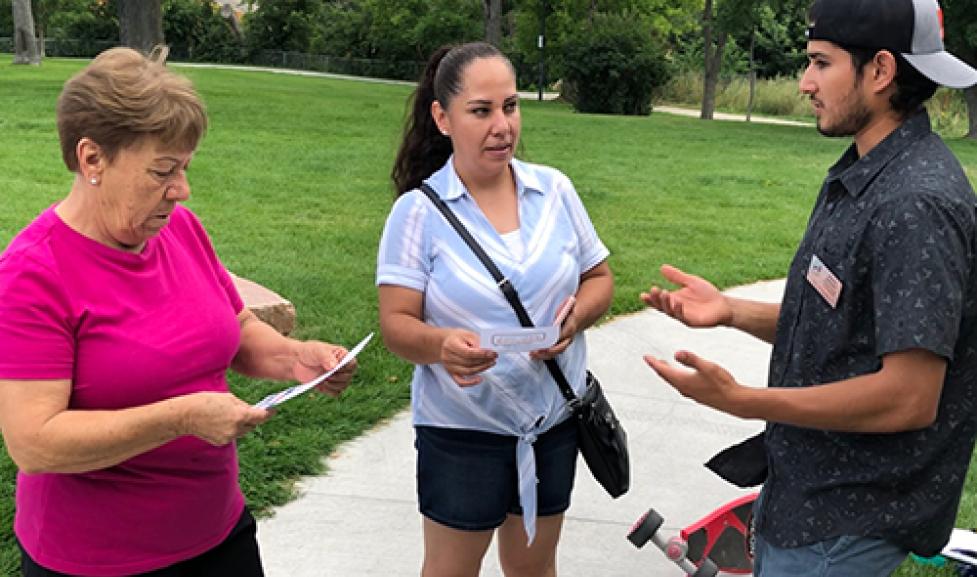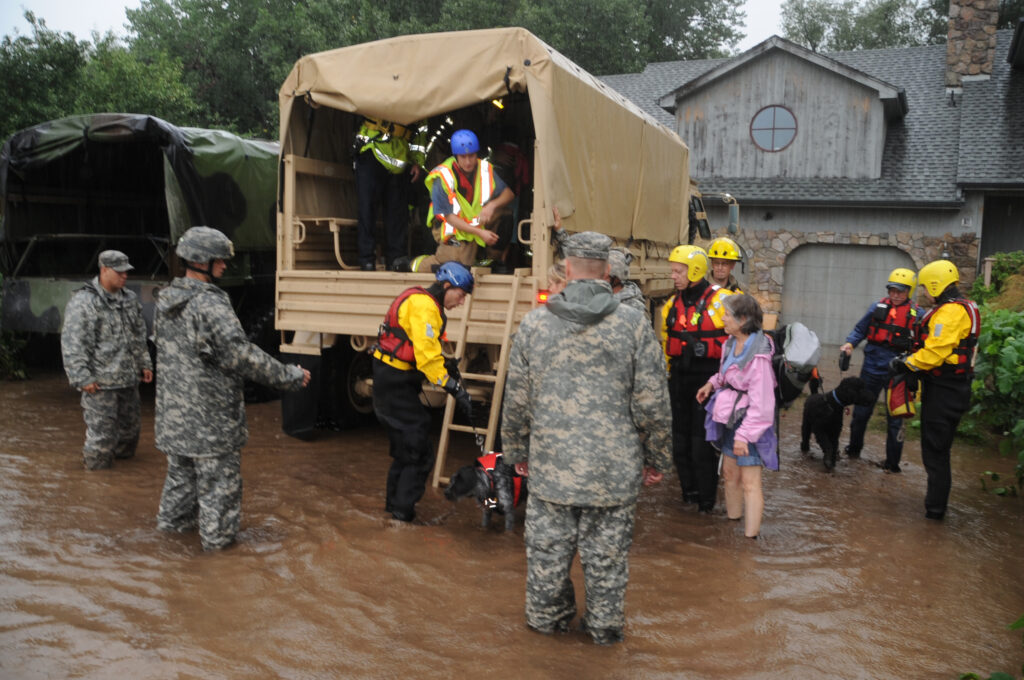
In December 2021, as the winds that blew the flames of the Marshall Fire ripped through south Boulder, causing trees to fall and destroying homes, Isabel Sanchez felt calm.
She ventured out from her home in the Mapleton Mobile Home Park to help a neighbor whose home had been damaged and came across a good friend of hers pacing nervously outside. She wondered aloud how Sanchez could possibly be so calm.
“I told her, ‘I feel very ready,’” Sanchez recalls. “If we have to evacuate, everything’s ready. She said to me, ‘Why don’t you teach a class?’”
Sanchez took the suggestion to heart, and in 2022 she helped found the Community Preparedness Training (CPT) program. CPT helps residents in mobile home communities, low-income communities and senior housing prepare for emergency situations by distributing resources and helping participants make evacuation plans.
“We are our [own] first responders,” Sanchez said. “We have to help our immediates because the emergency responders can’t get to us in an emergency when they’re being pulled everywhere.”
Across Boulder County, neighborhood leaders are forming groups that can activate if the worst happens — whether that be a natural disaster, a security threat or a global health emergency that causes the world to shut down.
Fostering connection
Dave Peattie swears that the best thing he’s ever done for disaster preparedness is make sangria.
He serves as the board president of The Berkeley Disaster Preparedness Neighborhood Network (BDPNN) in Berkeley, California, and spends significant time figuring out how the fabric of a community is weaved. BDPNN supports neighborhoods that are working to establish or reinvigorate collaboration between neighbors, helping them accomplish key steps in emergency preparation such as learning disaster first aid, creating emergency go kits and making an evacuation plan.
Before a community can establish an emergency network, neighbors need to do the simple but rare act of getting to know each other. Something as fun as a block party can lay the groundwork to eventually save a life during a disaster.
“The number one thing you can do is get to know your neighbors,” Peattie said. “If you care about your neighbors and they care about you, that’s how lives are actually saved.”
That can be easier said than done, Peattie said. People have busy lives filled with jobs, children and long to-do lists. Preparing for a hypothetical emergency can feel low on the priorities list.

That’s why Boulder resident Michael Le Desma decided to start small, creating a “pod” of people who live in direct proximity to each other, rather than attempting to reach the entire Martin Acres community.
“I don’t know the people on the north end of Martin Acres, they’re not my neighbors, in the sense that I see them every day, and I’m interacting with them,” Le Desma said. “My sense was that community building, it can be fairly far in its reach, but the further away it goes, the more diffuse it is.”
His homewwners association didn’t offer a productive environment for neighborhood conversations, often devolving into argument. As far as emergency situations, the messages coming from the HOA could sometimes be dangerously inaccurate, accidentally spreading outdated or incorrect information through its large email listserv.
He started his own neighborhood group, Neighbors United of South Boulder (NUSoBo), which meets in members’ homes to share food, drink and conversation about how to improve their neighborhood.
“It is very difficult to go into somebody else’s home and be eating their food, be in that space and simultaneously be an asshole,” Le Desma said.
In the pods, NUSoBo members use a consensus model, where they only take action if the entire group agrees on an idea. Once an action has been approved, people are expected to complete it.
“NUSoBo’s goal is to build these connections where we can lean on each other to get things done,” Le Desma said, “whether it’s personal or collective.”
‘What can we do?’
Even within “official” government disaster agencies, community building is central to prevention.
“Our underlying goal is that resilience piece,” said Brenda Cook Ritenour, neighborhood engagement and services manager for the City of Boulder. “If people know their neighbors and have good relationships with their neighbors, then they’re better positioned to help take care of each other no matter what happens.”

When Ritenour became Boulder’s neighborhood liaison in 2017, she reshaped the role to be more proactive. She worked to find natural neighborhood leaders who could communicate pressing needs to city officials and pass along resources back to their communities. Emergency Response Connectors operated during the COVID-19 pandemic, helping organize neighborhood testing sites and pop-up clinics, and during the Marshall Fire, when their on-the-ground updates helped the city orchestrate its own response.
The best way for neighbors to start connecting with each other will be different from place to place, but there are resources available to get started, said Boulder’s Neighborhood Services Program Manager, Edgar Chavarria.
“All these opportunities are possible,” Chavarria said. “All it really needs is for neighbors to have that creativity and imagination to think about, ‘What can we do to come together?’”
Start with the basics
When people join Community Preparedness Training — five weeks of three-hour classes — they can feel overwhelmed, Sanchez said. Often, participants have been through a disaster and can be triggered by all the potential threats they need to prepare for.
“Some people have not gone through it, but know someone that has,” Sanchez said. “And now you watch the news, and everywhere there’s tornadoes, fires, floods. We’re in bad shape; our planet is suffering.”

After the test pilot, Sanchez started incorporating calming practices into the program, teaching people to make tinctures for stress relief and lung support following smoke inhalation. Each class also starts with meditation, breathing exercises and a detox to help people feel relaxed and capable.
Emergency preparedness can take years, which can be paralyzing, said Claire Riley, who chairs the Wonderland Hills Fire Mitigation Committee. Unsure where to begin, they contacted the Boulder County Office of Disaster Management (ODM) and the City of Boulder Fire Department for guidance.
The city helped them identify inexpensive and simple ways to make their neighborhood less fire prone, like removing highly flammable juniper plants on HOA properties, Riley said. They worked with Monika Weber from ODM to prepare go-lists of items they need to bring in an evacuation — medicines, important documents, sentimental items, etc. — and then conducted an evacuation drill.
Neighbors knew what day the drill would happen, but not what time. When the alert popped up on their phones, they dropped whatever they were doing, set a timer, packed their go-bag, hopped in the car and stopped the timer.
“Some folks were done in five minutes; others came down when we had our little meeting afterwards, it took them 24 minutes,” Weber said. “It was helpful for them, because they were able to [realize] ‘Oh, if we do get all these items, that’s going to take us close to half an hour, and we’re maybe not comfortable with that, so we’re going to adjust things.’”
Preparing for everything
Taking time to assess personal risk factors — such as your mobility level or the reliability of your transportation — can feel scary, but having a plan in place means you’re better equipped to respond in a high-stress scenario, Weber said. Having neighbors involved also makes planning much more approachable. Maybe one neighbor has a vehicle, another has a generator and another has a backup water supply.
“We really encourage folks to talk to your neighbors, talk to your support system — whether that’s someone next door, someone five minutes away — to start to plan and just talk about these things, because we can’t do it individually,” Weber said.
Weber’s top piece of advice is to sign up for BOCO Alerts, which is how the county communicates about emergencies and recommended safety actions. Right now, only about 40% of county residents are signed up.
People should also listen to their instincts and not wait for an evacuation order if they feel unsafe, Weber said.

That’s what Joycelyn Fankhouser did during the 2013 flood.
At 11 p.m. the night of the floods, Fankhouser’s husband started to get nervous about the river near their Lyons home overflowing. They got up and went to check, and found that the water was already cresting above a bridge that crosses the river. They began knocking on neighbors’ houses, including a 90-year-old who lived next door, helping people evacuate.
The official flood sirens didn’t go off until 2 a.m. By that time, people were trapped in their homes, Fankhouser said. “We were all cut off.”
That experience led her to take time off from her job and begin volunteering with the Boulder County Department of Housing and Human Services to help coordinate flood recovery efforts. She helped found Lyons Prepared, a community group working to support each other and prevent another extreme isolation event.
Lyons Prepared doesn’t gear up for disasters like floods, Fankhouser said: They prepare for the outcomes of disasters: evacuation orders, power outages or water shutoffs. Planning for common impacts rather than every hypothetical disaster helps break the process down.
“If you prepare for each of those lifelines,” Fankhouser said, “you are then preparing for everything.”
‘You need your neighbors’
It’s important to make disaster preparedness fun and productive, and not instill a “doomsday prepper” fear in people, said Berkeley’s Peattie. Ideally, people are overly prepared for a disaster that never happens.
“I hope on one level, this is just a giant waste of time,” Peattie said. “It’s like insurance: You’re hoping you don’t have to ever use it, but you’re willing to pay into it because you know that the consequences could be huge.”
The work is never wasted, he said, because his quality of life is improving. He and his neighbors are much better acquainted, they know each other’s unique needs and abilities, they care about each other and rely on each other.
“What we’re seeing is neighbors who know each other,” he said. “And when you know each other, you don’t leave them behind.”
Fankhouser’s work with Lyons Prepared reminds her of a speech she heard from political scientist Daniel Aldrich, who found that, during a tsunami in Thailand, it was community connection that saved lives. Not money, not resources, but neighbors helping neighbors.
“In a really big emergency, there are not enough first responders,” Fankhouser said. “You need your neighbors.”
